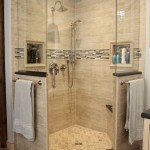Best Waterproof Flooring For Bathrooms
Bathrooms are unique environments within a home, constantly exposed to moisture and humidity. This necessitates flooring solutions that can withstand these conditions without warping, rotting, or harboring mold and mildew. Understanding the best waterproof flooring options available empowers homeowners to make informed decisions that balance aesthetics, durability, and budget.
1. Porcelain and Ceramic Tile
Porcelain and ceramic tiles stand as classic choices for bathroom flooring due to their inherent water resistance. These materials are fired at high temperatures, creating a dense, non-porous surface that repels water. Porcelain, in particular, has a lower water absorption rate than ceramic, making it even more suitable for wet areas. Glazed porcelain and ceramic tiles offer an extra layer of protection, further enhancing their waterproof capabilities.
Beyond their waterproof nature, porcelain and ceramic tiles provide design versatility. They come in a vast array of colors, patterns, and sizes, allowing homeowners to achieve various aesthetic goals. From mimicking the look of natural stone to creating intricate mosaic designs, these tiles cater to diverse stylistic preferences. Furthermore, their durability ensures long-lasting performance, making them a sound investment for high-traffic areas like bathrooms.
While generally easy to maintain, grout lines require regular sealing to prevent water penetration. The hard surface of tile can also feel cold underfoot, though radiant heating systems can mitigate this issue. Proper installation is crucial for ensuring the longevity and waterproof qualities of tile flooring.
2. Luxury Vinyl Plank (LVP) and Luxury Vinyl Tile (LVT)
Luxury vinyl flooring has gained immense popularity in recent years, specifically LVP and LVT, due to its exceptional waterproof properties and affordability. Constructed with multiple layers, including a waterproof core, these options provide superior protection against moisture. The top layer often features a realistic photographic image that mimics natural materials like wood or stone, offering an attractive alternative to the real thing.
LVP and LVT are known for their ease of installation, often featuring a click-lock system that allows for DIY projects. They are also more comfortable underfoot compared to tile and offer better sound insulation. Their resistance to scratches and dents makes them suitable for households with children and pets. Furthermore, the wide variety of styles and colors available ensures compatibility with various bathroom designs.
While highly water-resistant, prolonged exposure to standing water can still cause damage, especially if it seeps through seams. Regular cleaning and swift addressing of spills are recommended. Although durable, LVP and LVT may not be as long-lasting as porcelain or ceramic tile.
3. Sheet Vinyl Flooring
Sheet vinyl flooring provides a completely waterproof surface, making it a practical and budget-friendly choice for bathrooms. Manufactured as a single, continuous sheet, it eliminates the seams that can be vulnerable to water penetration in other flooring types. This feature makes it particularly well-suited for bathrooms prone to splashing and spills.
Modern sheet vinyl comes in a range of patterns and colors, offering flexibility in design choices. It is also relatively easy to install and requires minimal maintenance. The soft and resilient nature of sheet vinyl offers comfort underfoot and provides a warmer surface than tile. Its affordability makes it an attractive option for budget-conscious homeowners.
While waterproof, the subfloor beneath sheet vinyl must be properly prepared to prevent moisture issues. Tears or punctures can compromise the waterproof barrier, and repairs can be challenging. Compared to LVP and LVT, sheet vinyl may be perceived as less stylish, though advancements in printing technology are constantly improving its aesthetic appeal.
4. Engineered Wood with Waterproof Core
Engineered wood flooring with a waterproof core offers the warmth and beauty of natural wood with enhanced resistance to moisture. Unlike solid hardwood, engineered wood consists of layers of wood veneer bonded to a core, usually plywood or high-density fiberboard. Recent innovations have introduced waterproof cores, making this option suitable for bathroom applications.
The top layer of real wood provides the authentic look and feel of hardwood, while the waterproof core protects against moisture damage. This combination offers a balance of aesthetics and practicality for bathrooms. Engineered wood is generally easier to install than solid hardwood and can be installed over various subfloors. It also offers better dimensional stability than solid hardwood, meaning it is less susceptible to warping or shrinking due to changes in humidity.
While the waterproof core provides significant protection, standing water should still be avoided. The surface layer, although sealed, can still be susceptible to scratches and dents. Proper maintenance is necessary to ensure the longevity of engineered wood in a bathroom environment. It’s important to note that not all engineered wood is waterproof, so careful selection is crucial.

Waterproof Bathroom Flooring Options Twenty Oak

The Best Waterproof Flooring That Isn T Tile

Waterproof Bathroom Flooring Options Twenty Oak

Learn More About The Best Options For Waterproof Flooring Triad And Bath

Waterproof Vinyl Flooring The Bathroom Showroom

What Is The Best Floorcovering For A Bathroom Floor Lopco Contracting Ri

What S The Best Waterproof Flooring

Best Bathroom Flooring Options

Luxury Vinyl Flooring Is A Great Choice For Chic Bathrooms

Bathroom Flooring Ideas The Home







